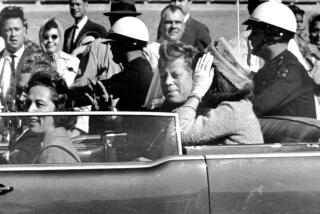Kennedy and Friend Personalize the Bill of Rights
SAN FRANCISCO — As law students, Caroline Kennedy and Ellen Alderman wondered often about the human dimension of the cases they studied in a class on civil rights. Why not a book, they asked themselves, not just on individual liberties but also on the people whose plights produced important cases?
With the encouragement of their professor, they began scouring lawbooks, tracking down lawyers and interviewing litigants all the way from an Indian reservation in California to a prison Death Row in Arizona.
The result is a book by the daughter of President John F. Kennedy and her colleague on the Bill of Rights--the first 10 amendments to the Constitution--that tells the personal stories behind a series of cases involving key individual freedoms.
There is, of course, no shortage of scholarly works on the Constitution, but complex legal analyses often prove forbidding to the layman. Moreover, polls have shown Americans to be disturbingly ignorant of the Bill of Rights (a 1987 poll showed 59% could not identify it).
Nonetheless, to the surprise and huge delight of Kennedy and Alderman, their book, “In Our Defense: The Bill of Rights in Action,” has climbed quickly to bestseller lists in the few weeks it has been on sale. And the authors sense renewed interest in the subject as the country marks the 200th anniversary of the adoption of the document.
“We’re so lucky to have the Bill of Rights,” Kennedy said Wednesday as she and Alderman paused during a round of interviews here before scheduled stops in Los Angeles today. “It’s something we should be interested in.”
Judging from the calls they have taken as guests on radio talk shows, there is considerable eagerness to debate freedom of speech, the right to bear arms, the validity of capital punishment and other legal controversies that arise under the amendments.
Parents are buying the book for their children and high school students have told the authors that their teachers are using the book in class. The book has gained some impressive endorsements, including one from Harvard constitutional law specialist Laurence H. Tribe, who on the book jacket calls it “a thrilling chronicle of unending adventure.”
Kennedy and Alderman, now both New York attorneys, met as classmates at Columbia Law School. In 1987, they enrolled in a class on civil rights taught by Jack Greenberg, former head of the NAACP Legal Defense Fund and a well-regarded rights advocate. While studying civil rights law, they hit upon the idea of writing about each of the 10 amendments, using individual cases to explain the importance of the issues in readily understandable terms. To make the Bill of Rights come to life, they proposed to focus on the human dimensions of the cases as well.
Encouraged by Greenberg and other experts, Kennedy and Alderman haunted the law library and searched through hundreds of cases before settling on those that would best tell the story. Then they sought out the lawyers in those cases and traced down litigants from coast to coast. Some were surprised to get a call from the late President’s daughter and her co-author, but only a few (including a gun-control foe and an accused child molester) refused to cooperate.
One journey took Kennedy and Alderman to the forests of Northern California, where Indian tribal members, asserting their First Amendment right to free exercise of religion, sued the government to prevent a road from being built through lands they considered sacred. There, the authors witnessed ancient tribal religious ceremonies and talked at length with the tribesmen.
“They were very honest: they really didn’t want to talk about their religion,” recalled Kennedy. “But they also felt there was a need to explain why the law was so important to them.” In the end, the tribesmen lost before the U.S. Supreme Court, but the road was later blocked through federal legislation.
The authors also explored an unsuccessful attempt by the government to prevent the Progressive magazine from publishing an article on how H-bombs are made; a long legal struggle by a Kentucky couple to sue government officials over the illegal search of their home for subversive documents; and an Arizona case resulting in a U.S. Supreme Court ruling allowing the death penalty for certain accomplices who do not intend that a crime victim be killed.
With their Bill of Rights project complete, Alderman plans to return to practice law in New York while Kennedy is undecided about her immediate professional future. Both pronounce their experience with the book highly satisfying. Their aim, they said, was to air both sides in the cases they wrote about and let the readers form opinions themselves.
“Meeting the people involved gives you another dimension,” said Kennedy. “You become more compassionate, really, for both sides.”
More to Read
Sign up for our Book Club newsletter
Get the latest news, events and more from the Los Angeles Times Book Club, and help us get L.A. reading and talking.
You may occasionally receive promotional content from the Los Angeles Times.






